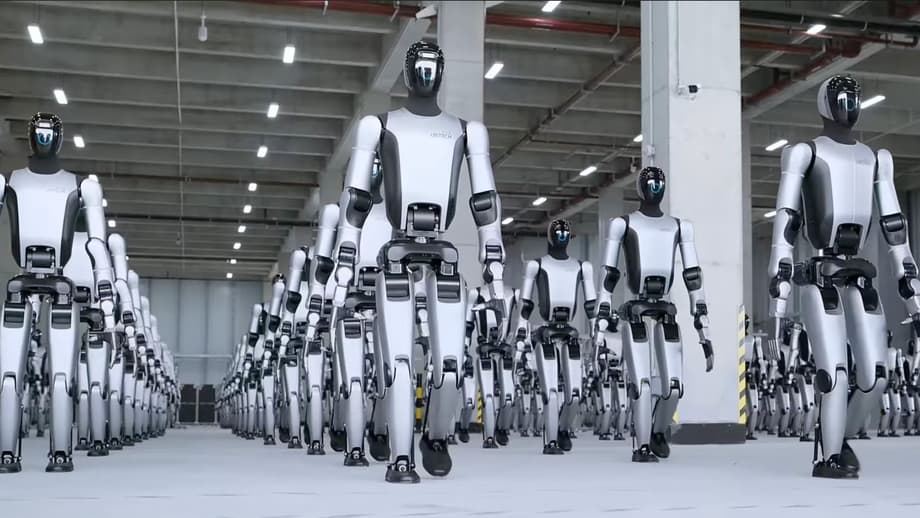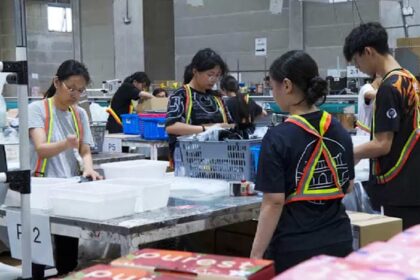Why hundreds of humanoids are heading to assembly lines
Shenzhen-based UBTECH Robotics says it has shipped hundreds of Walker S2 humanoid robots to active industrial sites across China, marking what the company calls the first mass delivery of humanlike robots for factory work. Production ramped in mid November, and the first batches are already arriving at customers that want extra labor on assembly lines and in warehouses. The order book for 2025 has crossed 800 million yuan (about 113 million dollars), and UBTECH plans to deliver 500 units by the end of December. Early deployments are focused on repetitive, mobile, and ergonomic tasks that usually keep human workers on their feet for long stretches.
- Why hundreds of humanoids are heading to assembly lines
- Who is buying them and what will they do
- Inside Walker S2, design and capabilities
- Why factories care about the humanoid form
- Orders, revenue, and market momentum
- How this compares to rivals
- Viral video, questions, and what proof will matter
- Key Points
A milestone in the humanoid race
Up to now, most humanoid projects have run as limited pilots or lab demos. UBTECH says the Walker S2 has been available to industrial buyers since July and is now moving from showcase videos to regular factory duty. The company frames this rollout as a shift from research to production at meaningful volume, with customers that include major automakers and electronics manufacturers. The early use cases are designed to prove reliability and value outside controlled environments.
Who is buying them and what will they do
Automakers and electronics suppliers are driving demand. BYD, Geely Auto, FAW Volkswagen, Dongfeng Liuzhou Motor, and Foxconn are among the first wave of customers. UBTECH disclosed a string of contracts this year, including a 250 million yuan order in September from a major Chinese enterprise, a 159 million yuan order from a company in Zigong in Sichuan province, a 126 million yuan commitment linked to a data center project in Guangxi, and more than 100 million yuan from Miee Auto in Hubei. Deals range from specialized installations to larger deployments across multiple sites.
The first Walker S2 teams are taking on parts sorting, kitting, and material movement inside production areas. In warehouses they are moving goods between shelves, receiving docks, and packing stations. These tasks call for continuous walking, grasping, and placement with consistent force. Customers want day and night operations with minimal oversight. Early testing outside the lab has focused on keeping cycle times stable while reducing human fatigue on repetitive motions.
Inside Walker S2, design and capabilities
Walker S2 is built to be tall and sturdy, with joints that move like those of a person. The robot can handle heavier items while maintaining precise control at the fingertips. UBTECH’s core pitch centers on energy management. The company says Walker S2 can remove and replace its own battery within minutes without help from a human operator. Short swap times reduce downtime and keep the robot on task across long shifts.
Autonomous battery swapping explained
Battery swapping is meant to be routine and repeatable. A Walker S2 approaches a dock, unlatches its discharged pack, slides it into a charging bay, retrieves a fully charged pack, and installs it in its own chassis. The robot confirms the connection, runs quick checks, and returns to work. This approach avoids long pauses while the robot sits on a charger. It also reduces the need for staff to manually handle battery packs. With several charged packs staged near the workspace, the fleet can rotate through swaps and keep a steady cadence.
Walker S2 is designed for perception and balance in busy spaces. Sensors and cameras help the robot navigate around people, carts, and pallets. Control software coordinates walking, grasping, and placement, aiming for predictable contact forces and safe movements in mixed environments. The goal is steady throughput, fewer micro stoppages, and repeatable performance on constrained factory floors.
Why factories care about the humanoid form
Most industrial sites are built around people, tools, and workstations at human height. Reconfiguring these spaces for new fixed automation can be costly and time consuming. A general purpose humanoid can use existing aisles, shelves, tools, and doors. It can be reassigned across stations or even across buildings when demand shifts. That flexibility is attractive for manufacturers that face frequent changeovers, short product cycles, and fluctuating staffing.
Humanoids are not a blanket replacement for every job. High speed pick and place or heavy welding remain better suited to fixed industrial arms and custom machinery. The sweet spot for a humanoid is work that involves walking between tasks, using common tools, and interacting with equipment that was designed for people. That includes kitting, bin picking at moderate speeds, material staging, and simple inspection with hand carried sensors or fixtures.
Orders, revenue, and market momentum
UBTECH’s disclosed contracts indicate broad interest across regions and sectors in China. The company aims to deliver 500 Walker S2 units by the end of December. The share of humanoid products in UBTECH’s total sales has risen to about 30 percent in 2025, up from roughly 10 percent a year earlier. That shift signals growing production capacity and stronger customer demand.
In the first half of 2025, UBTECH reported revenue of 621 million yuan, a year over year increase of 27.5 percent. Gross profit reached 217 million yuan, up 17.3 percent. The company still posted a net loss of 440 million yuan, yet losses narrowed by 18.5 percent compared with the prior year. Management says it is improving the cost structure while expanding factory output.
Investors have taken notice. The stock has climbed more than 150 percent this year to about 133 Hong Kong dollars. Brokerages such as Citi and JPMorgan keep buy ratings, with price targets above 170 Hong Kong dollars. UBTECH became the first robotics company to list on the Hong Kong exchange in 2023, and the new deliveries are central to its growth story.
How this compares to rivals
Global players are racing to bring humanoids from lab prototypes into real work. Tesla has previewed Optimus. Figure is piloting its Figure 01 with automotive partners. Agility Robotics is advancing Digit for warehouse tasks. Many of these efforts remain in pilot phases with small fleets and controlled environments. UBTECH’s claim rests on scale and location. The company says it is placing hundreds of units inside active factories rather than demonstration labs.
UBTECH also argues that self service energy management can be a differentiator. Many robots rely on plug in charging or human assisted battery changes. A reliable and fast autonomous swap routine could cut staffing needs for maintenance and raise uptime. That advantage only holds if swap stations are affordable, safe, and easy to service on busy factory floors.
Viral video, questions, and what proof will matter
A promotional video showing rows of Walker S2 units marching into shipping containers drew millions of views and mixed reactions. Some viewers praised the level of coordination. Others questioned whether parts of the scene were rendered with CGI. Brett Adcock, the chief executive of Figure, publicly suggested on social media that portions of the footage might be computer generated. UBTECH has promoted the start of mass delivery and said hundreds of units are being sent to partners. The decisive evidence will come from performance at customer sites, not from marketing clips.
Evidence in the field
Data from production lines will tell the story. Manufacturers will look for uptime, safe interaction with people and machines, consistent cycle times, and a lower cost per completed task. Early work in factories and warehouses indicates the robots can operate beyond lab settings. As deployments with BYD, Geely Auto, FAW Volkswagen, Dongfeng Liuzhou Motor, and Foxconn mature, feedback on reliability, maintenance windows, and return on investment will be the key measures of success. The speed and scale of follow on orders will show whether the Walker S2 can anchor long term roles in routine industrial work.
Key Points
- UBTECH has shipped hundreds of Walker S2 humanoid robots to active factories in China after ramping production in mid November.
- Orders for 2025 exceed 800 million yuan (about 113 million dollars), and the company plans to deliver 500 units by year end.
- Early customers include BYD, Geely Auto, FAW Volkswagen, Dongfeng Liuzhou Motor, and Foxconn.
- Large contracts disclosed include 250 million yuan from a major enterprise, 159 million yuan from a company in Zigong, and 126 million yuan for a Guangxi project, with more than 100 million yuan from Miee Auto.
- Walker S2 can swap its own battery without human assistance, cutting downtime and enabling long shifts.
- Initial tasks involve parts handling, kitting, and warehouse logistics, with continuous operation and minimal oversight.
- Humanoid products now account for about 30 percent of UBTECH sales, up from roughly 10 percent a year earlier.
- First half 2025 revenue reached 621 million yuan, gross profit 217 million yuan, and net loss narrowed to 440 million yuan.
- The stock has risen more than 150 percent to around 133 Hong Kong dollars, with buy ratings and targets above 170 Hong Kong dollars from major brokerages.
- A viral video stirred debate about authenticity, yet lasting adoption will depend on uptime, safety, and cost at customer sites.












